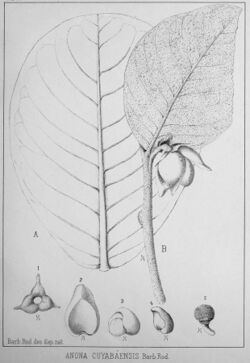Biology:Annona dioica
| Annona dioica | |
|---|---|

| |
| Botanical illustration of Annona dioica using they synonym A. cuyabaensis[1] | |
| Scientific classification | |
| Kingdom: | Plantae |
| Clade: | Tracheophytes |
| Clade: | Angiosperms |
| Clade: | Magnoliids |
| Order: | Magnoliales |
| Family: | Annonaceae |
| Genus: | Annona |
| Species: | A. dioica
|
| Binomial name | |
| Annona dioica | |
| Synonyms | |
| |
Annona dioica is a species of plant in the family Annonaceae. It is native to Bolivia, Brazil and Paraguay.[3] Augustin Saint-Hilaire, the French botanist who first formally described the species, named it after its flowers which have different reproductive structures (δίς, dís, two in Greek) and (οἶκος, oîkos, house in Greek).
Description
It is a bush reaching 0.5-2 meters in height. Its oval, hairy leaves are 5-16 by 3-15 centimeters and have rounded tips. Its petioles are 2.25-4.5 millimeters long and covered in wooly hair. Its inflorescences consist of 1-3 curved peduncles that are 2-3.4 centimeters long and covered in rust-colored hairs. Its flowers have a diameter of 6.75 centimeters. Its calyx has triangular lobes. Its yellow-green outer petals are oval-shaped, leathery, hairy and come to a shallow point at their tips. The inner petals are smaller than the outer. Its stamens have 4 millimeter long filaments and anthers that are 4 times as long.[4][5]
Reproductive biology
The pollen of Annona dioica is shed as permanent tetrads.[6] Plants are androdioecious with flowers that are both male and female, or male only. Pollination is mediated by the Cyclocephala atricapilla beetle.[7]
Distribution and habitat
It grows at elevations of 80-1000 meters. It blossoms in December.[5]
Uses
Extracts from the leaves and wood contain bioactive compounds.[8][9] Parts of the plant are used in Brazilian traditional medicine to treat a variety of ailments including diarrhea and rheumatism.[10]
References
- ↑ Rodrigues, João Barbosa (1898) (in Portuguese, Latin). Plantae mattogrossenses, ou, relação de plantas novas : colhidas, classificadas e desengadas. Rio de Janeiro: Leuzinger. p. 5. https://www.biodiversitylibrary.org/item/213591.
- ↑ Botanic Gardens Conservation International (BGCI).; IUCN SSC Global Tree Specialist Group (2019). "Annona dioica". IUCN Red List of Threatened Species 2019: e.T143322153A143322155. doi:10.2305/IUCN.UK.2019-1.RLTS.T143322153A143322155.en. https://www.iucnredlist.org/species/143322153/143322155. Retrieved 19 November 2021.
- ↑ "Annona dioica A.St.-Hil.". The Trustees of the Royal Botanic Gardens, Kew. n.d.. https://powo.science.kew.org/taxon/urn:lsid:ipni.org:names:72192-1.
- ↑ Saint-Hilaire, Auguste de (1825) (in Latin, French). Flora Brasiliae meridionalis. 1. Paris: Apud A. Belin. https://www.biodiversitylibrary.org/item/98641.
- ↑ 5.0 5.1 Maas, Paul J. M.; de Kamer, Hiltje Maas-van; Junikka, Leo; de Mello-Silva, Renato; Rainer, Heimo (2001). "Annonnaceae from Central-eastern Brazil". Rodriguésia 52 (80): 65–98. doi:10.1590/2175-78602001528005. ISSN 2175-7860.
- ↑ Walker, James W. (1971). "Pollen Morphology, Phytogeography, and Phylogeny of the Annonaceae". Contributions from the Gray Herbarium of Harvard University 202 (202): 1–130. doi:10.5962/p.272704.
- ↑ Gottsberger, Gerhard (1989). "Beetle pollination and flowering rhythm ofAnnona spp. (Annonaceae) in Brazil". Plant Systematics and Evolution 167 (3–4): 165–187. doi:10.1007/BF00936404. ISSN 0378-2697.
- ↑ Vega, Maria R. G.; Esteves-Souza, Andressa; Vieira, Ivo J. C.; Mathias, Leda; Braz-Filho, Raimundo; Echevarria, Aurea (2007). "Flavonoids from Annona dioica leaves and their effects in Ehrlich carcinoma cells, DNA-topoisomerase I and II". Journal of the Brazilian Chemical Society 18 (8): 1554–1559. doi:10.1590/S0103-50532007000800016. ISSN 0103-5053.
- ↑ Santos, Paulo R. D. dos; Morais, Anselmo A.; Braz-Filho, Raimundo (2003). "Alkaloids from Annona dioica". Journal of the Brazilian Chemical Society 14 (3): 369–400. doi:10.1590/S0103-50532003000300009. ISSN 0103-5053.
- ↑ Formagio, Anelise S N; Kassuya, Candida A L; Neto, Frederico Formagio; Volobuff, Carla R F; Iriguchi, Edna K K; Vieira, Maria do C; Foglio, Mary Ann (2013). "The flavonoid content and antiproliferative, hypoglycaemic, anti-inflammatory and free radical scavenging activities of Annona dioica St. Hill". BMC Complementary and Alternative Medicine 13 (1): 14. doi:10.1186/1472-6882-13-14. ISSN 1472-6882. PMID 23311341.
External links
Wikidata ☰ Q15400785 entry
 |


